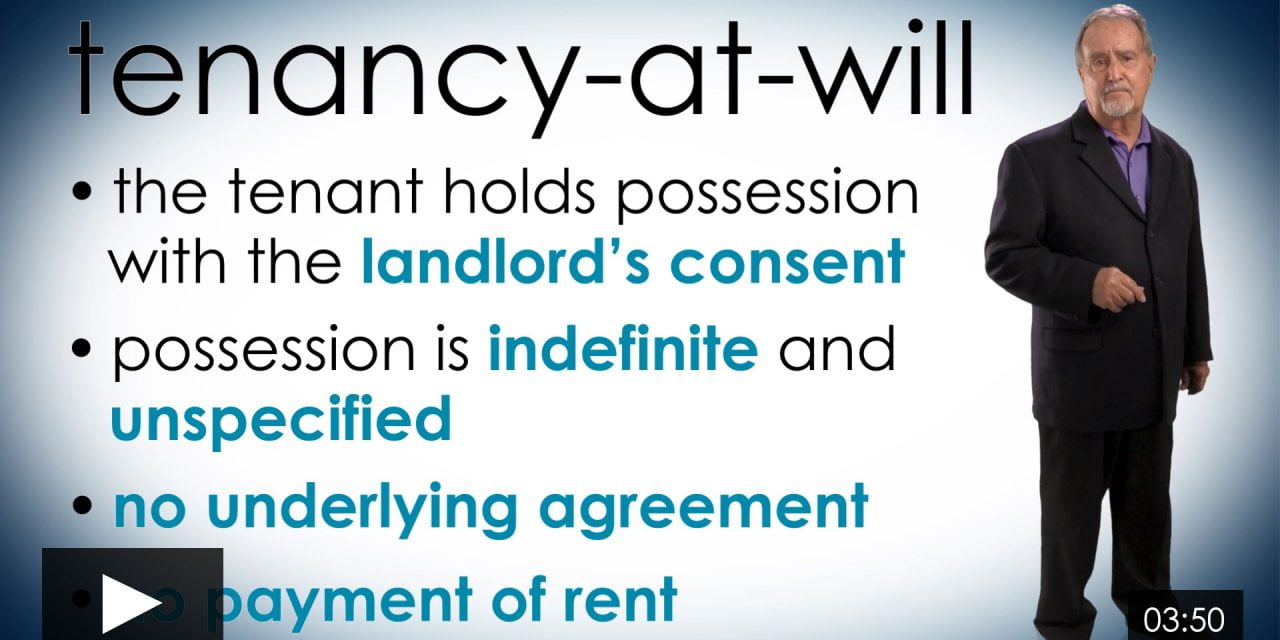For the prior video in this series covering the use of a rental agreement to structure a periodic tenancy, click here.
Introducing tenancy-at-will
Fixed-term and periodic tenancies are the most common type of leasehold estates. But there are others, such as a tenancy-at-will, also known as an estate at will.
The characteristics of a tenancy-at-will include:
- the tenant possesses the property with the landlord’s knowledge and consent, frequently after the termination of a lease;
- possession is provided for an indefinite and unspecified period of time;
- there is no underlying rental or lease agreement, or the agreement has expired; and
- there is no provision for the payment of rent.
A common example of a tenancy-at-will is when a family member allows another family member to live in their property without any type of agreement whatsoever and without paying any rent.
This meets all the criteria: possession is mutually agreed to, possession is indefinite, there is no underlying agreement documenting the arrangement, and the family member does not pay rent to the other family member.
Situations giving rise to a tenancy-at-will include:
- when a tenant is granted the right to indefinitely occupy the property in exchange for services rendered [Covina Manor Inc. Hatch (1955) 133 CA2d Supp. 790; see RPI Form 591];
- when a tenant is given possession of property under an unenforceable lease agreement (e.g., a written lease not signed by either party or on terms orally agreed to) — unless rent is accepted which creates a periodic tenancy [Psihozios Humberg (1947) 80 CA2d 215]; or
- when a tenant is given possession of the property while lease negotiations regarding the rent amount are still in progress and rent is not accepted. [Miller Smith (1960) 179 CA2d 114]
For a tenancy-at-will, a written three-day notice to pay rent or quit is all that is required to implement any change in the right to continue to occupy the premises – for instance, change it to a different kind of tenancy or terminate the tenancy. Contrast this with the more onerous notice requirements for terminating a periodic tenancy.
A resident manager’s occupancy
Relatedly, a tenancy-at-will situation often presents itself in the context of a resident manager whose right to occupy a property is granted in exchange for providing property management services.
Consider a broker who, retained to manage a residential income property, enters into an employment agreement with a resident manager to oversee the daily management of the property. This employment agreement is called a resident manager agreement. [See RPI Form 591]
Under the resident manager agreement, the resident manager:
- acknowledges employment by the property manager;
- accepts the occupancy and use of an apartment unit rent-free as compensation for the employment; and
- agrees to vacate the property on termination of employment.
The resident manager’s job is to show vacant units, run credit checks, negotiate and sign leases, collect rents, supervise repairs and maintenance, serve notices and perform other non-discretionary administrative activities.
Later, the property manager terminates the resident manager’s employment. The property manager demands the resident manager immediately vacate the premises and relinquish possession of the unit. However, the resident manager claims to be a tenant, entitled to a notice and time to vacate, not just a notice terminating employment and their right of possession of the unit.
Is the resident manager entitled to a notice and time to vacate on termination of employment?
No! A resident manager who continues to occupy a unit after their employment is terminated becomes a holdover tenant. They unlawfully detain the unit and have no right to a notice other than the notice terminating their employment. A resident manager’s occupancy is fixed, not periodic. It is established in the resident manager agreement that the resident manager’s tenancy ends on the date their employment is terminated. [Karz v. Mecham (1981) 120 CA3d Supp. 1]
Also, the resident manager’s eviction by an unlawful detainer (UD) action is not protected by rent control ordinances. Further, they may not defend their continued possession by demanding the property manager or landlord show good cause for terminating their employment. [Tappe v. Lieberman (1983) 145 CA3d Supp. 19]
If the resident manager does not relinquish possession on termination of the resident manager’s employment, the property manager may immediately file a UD action, without further notice, to have the resident manager evicted.
However, a resident manager agreement may provide for the creation of a tenancy following the termination of a resident manager’s employment. When a tenancy is agreed to, the resident manager’s right of possession is not terminated on termination of the resident manager employment, but under landlord-tenant rules of notice before eviction. [Calif. Code of Civil Procedure §1161(1)]
A resident manager’s duties may include:
- screening tenants and negotiating leases;
- cleaning vacated units;
- supervising landscaping, maintenance and repairs;
- serving notices; or
- attending to tenant inquiries.
Both residential income property and commercial property may have resident managers. However, apartment buildings with 16 or more units are required to have a landlord, resident manager or responsible caretaker living on the premises to manage the property. [25 Calif. Code of Regulations §42]
Resident managers do not need to be licensed as a real estate broker or agent to negotiate leases or collect rents. However, if a nonresident property manager is not the landlord, the nonresident property manager needs to be licensed by the Department of Real Estate (DRE) as a real estate broker. [Calif. Business and Professions Code §10131.01]














